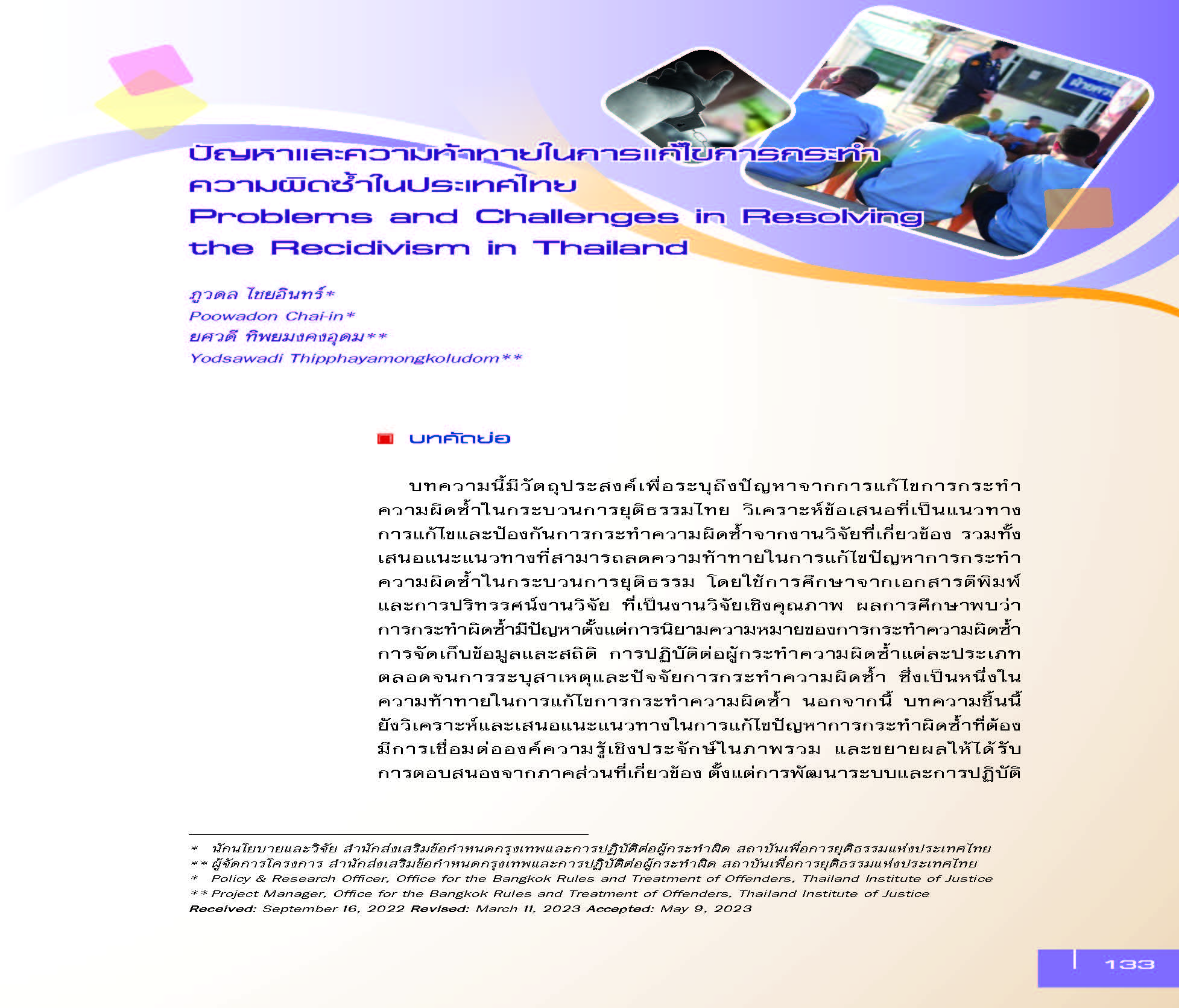Problems and Challenges in Resolving the Recidivism in Thailand
Main Article Content
Abstract
This article seeks to clarify the problems from recidivism solving in the Thai criminal justice system. Research materials on the prevention of recidivism were analyzed and guidelines on challenges in resolving recidivism were recommended. Document research and review article based on quantitative methods were applied. The results showed that problems of recidivism were preliminarily existing in the definition of recidivism, data and statistical collection, treatments for specific group of recidivists, and the identification of the main causes and factors of recidivism which are significant challenges to tackling the issue. In addition, the resolution of recidivism under concrete research integration and stakeholder collaboration was analyzed and proposed. This included criminal justice system and treatment of offender development, social and economic policy development, improvement of legal measures, and the application of research-based evidence. This article proposes a holistic approach to resolve the problem of recidivism under the criminal justice system based on contexts and research findings. Moreover, proper suggestions of policy support to resolve the recidivism for criminal justice organizations in Thailand were recommended.
Article Details

This work is licensed under a Creative Commons Attribution-NonCommercial-NoDerivatives 4.0 International License.
Published Manuscripts are the copyright of the Journal of the Justice System. However; the opinions that appeared in the content are the sole responsibility of the author.
References
กรมราชทัณฑ์. (2564ก). รายงานสถิติผู้ต้องราชทัณฑ์. ค้นเมื่อ 12 พฤศจิกายน 2564, จาก http://www.correct.go.th/stathomepage/
กรมราชทัณฑ์. (2564ข). สถิติการกระทำผิดซ้ำของผู้ต้องขัง. ค้นเมื่อ14 พฤศจิกายน 2564, จาก http://www.correct.go.th/recstats/index.php
ชญาณ์นันท์ บวรสมสฤษดิ์ และศรีสุพร ปิยรัตนวงศ์. (2553). ปัจจัยในการกระทำผิดซ้ำของผู้ต้องขังคดียาเสพติดในทัณฑสถานบำบัดพิเศษสงขลา. วารสารกระบวนการยุติธรรม, 3(4), 79-83.
ชวลิต กลิ่นแข, เกชา ใจดี, ณฐวรรธน์ เสมียนเพชร, สุพัตรา สมวงศ์ และทิพวรรณ์ สุวรรณโน. (2563). ปัจจัยที่ส่งผลต่อการ กระทำผิดซ้ำของผู้ต้องขังในเรือนจำของจังหวัดแม่ฮ่องสอน. วารสารวิชาการสถาบันวิทยาการจัดการแห่งแปซิฟิค, 6(3), 253-261.
ฐิติวรรณ สุกใส, เชิดศักดิ์ โฆวาสินธุ์, วันเพ็ญ วอกลาง และธวัชชัย ไทยเขียว. (2555). ปัจจัยที่มีอิทธิพลต่อการกระทำผิดซ้ำของเด็กและเยาวชนในสังคมไทย. วารสารดุษฎีบัณฑิตทางสังคมศาสตร์, 2(3), 8-19.
ทรรศพล ขุนรัง. (2556). สาเหตุการกระทำผิดซ้ำคดีเกี่ยวกับทรัพย์: ศึกษาเฉพาะกรณีความผิด ฐานลักทรัพย์ นักโทษเด็ดขาดฝ่ายควบคุมแดน 8 เรือนจำพิเศษกรุงเทพมหานคร. สารนิพนธ์ศิลปศาสตรมหาบัณฑิต. มหาวิทยาลัยเกริก.
ธีระ สินเดชารักษ์, จตุรพิธ เกราะแก้ว, นัจชลี ศรีมณีกาญจน์, ปองพล นิลพฤกษ์, วิเชษฐ์ พลายมาศ, พิเชฐ คุณากรวงศ์, ธนบูรณ์ จันทรมาลัย, พงษ์กฤษณ์ มงคลสินธุ์,เกษมศานต์ โชติชาครพันธุ์, เปรมฤดี เพ็ชรกูล, ธิติ มหาเจริญ, ปวริศร เลิศธรรมเทวี และสุณีย์ กัลยจิตร. (2564). โครงการวิจัยเพื่อแก้ไขปัญหาการกระทำผิดซ้ำ: รายงานการวิจัย. ค้นเมื่อ 12 พฤศจิกายน 2564, จาก https://digital.library.tu.ac.th/tu_dc/frontend/Info/item/dc:179217
นัทธี จิตสว่าง. (ม.ป.ป.). สถิติการกระทำผิดซ้ำของผู้ต้องขังในประเทศไทย แหล่งรวบรวมความรู้ด้านอาชญาวิทยาและการบริหารงานยุติธรรม. ค้นเมื่อ 12 พฤศจิกายน 2564, จาก http://www.nathee-chitsawang.com/สถิติการกระทำผิดซ้ำของ
ปิรัชญาภรณ์ บุญชู. (2558). ปัจจัยที่มีอิทธิพลต่อการกระทำผิดซ้ำของผู้ต้องขังเรือนจำพิเศษธนบุรี. วารสารสหวิทยาการ, 12(2), 102-129.
ปวริศร เลิศธรรมเทวี. (2564). กฎหมายที่ไม่เอื้อต่อการกลับไปใช้ชีวิตในสังคมของผู้กระทำความผิด. วารสารรามคําแหง ฉบับนิติศาสตร์, 10(1), 261-306.
พงษ์กฤษณ์ มงคลสินธุ์. (2561). การศึกษาปัจจัยที่มีความสัมพันธ์กับการกระทำผิดซ้ำในคดียาเสพติด.วารสารวิชาการแสงอีสาน, 15(1), 47-63.
พรรณวดี คำไชยวงค์. (2564). การแปลงเปลี่ยนพฤติกรรมและความสำเร็จในการกลับคืนสู่สังคม: จากนักโทษสู่นักกีฬาอาชีพ. วารสารสันติศึกษาปริทรรศน์ มจร, 9(2), 535-547.
พัชรินทร์ ซำศิริพงษ์. (2561). การกระทำผิดซ้ำของเด็กและเยาวชนในคดียาเสพติด. วารสารวิจัยราชภัฏกรุงเก่า สาขามนุษยศาสตร์และสังคมศาสตร์, 5(3), 23-30.
วรกร โอภาสนันท์, (ม.ป.ป.). การวางมาตรการทางกฎหมายเพื่อป้องกันการกระทำความผิดซ้ำของผู้กระทำความผิดอุกฉกรรจ์ที่ใช้ความรุนแรง (Serious Offenders). สำนักงานคณะกรรมการกฤษฎีกา. ค้นเมื่อ 26 พฤศจิกายน 2564, จาก http://web.krisdika.go.th/data/activity/act13810.pdf
วรปพัฒน์ มั่นยา และศุภกร ปุญญฤทธิ์. (2563). สาเหตุและแนวทางการป้องกันการกระทำผิดซ้ำของผู้ต้องขังในคดีลักทรัพย์: กรณีศึกษาเรือนจำจังหวัดปทุมธานี. วารสารวิชาการสถาบันวิทยาการจัดการแห่งแปซิฟิค, 6(3), 74-83.
ศิริวรรณ กมลสุขสถิต. (2563). แนวทางในการป้องกันและแก้ไขการกระทำผิดซ้ำของเด็กและเยาวชนในคดีความผิดเกี่ยวกับยาเสพติดโดยอาศัยปัจจัยที่เป็นตัวทำนายทางด้านอาชญาวิทยา. วารสารวิชาการคณะมนุษยศาสตร์และสังคมศาสตร์ มหาวิทยาลัยราชภัฏนครสวรรค์, 7(1), 1-19.
ศิลป์ชัย ลีลิตธรรม และวงศกร เพิ่มผล. (2564). การศึกษาปัจจัยและแนวทางป้องกันตามหลักเบญจศีล เพื่อส่งเสริมการไม่กระทำความผิดซ้ำของผู้ต้องขังในเรือนจำจังหวัดสมุทรปราการ. วารสารวิชาการมนุษยศาสตร์และสังคมศาสตร์ มหาวิทยาลัยราชภัฏธนบุรี, 4(1), 51-68.
สำนักงานกิจการยุติธรรม. (2562). รายงานสรุปกรอบกฎหมายและมาตรการในการป้องกันการกระทำผิดซ้ำในคดีทางเพศ. ค้นเมื่อ 26 พฤศจิกายน 2564, จาก https://justicechannel.org/wp-content/uploads/2021/07/รายงาน-การกระทำผิดซ้ำคดีทางเพศ-code.pdf
สำนักวิจัยและพัฒนาระบบงานราชทัณฑ์. (2550). การปรับปรุงและพัฒนาระบบการจัดเก็บข้อมูลผู้ต้องขังกระทำความผิดซ้ำ. ค้นเมื่อ 26 พฤศจิกายน 2564, จาก https://nctc.oncb.go.th/manage/researchMgt/import/researchFull/20170301_10124950_Database_Development.pdf
สุภัทรา ปกาสิทธิ์ วโรตม์สิกขดิตถ์ และจุฑารัตน์ พรพุทธศรี. (2563). การกระทำผิดซ้ำ: นิยามและสถิติข้อมูลของกระทรวงยุติธรรม. วารสารกระบวนการยุติธรรม,13 (2), 167-182.
Bendlin, M., Sheridan, L., & Johnson, A. (2022). Stalking Recidivism: A Comparison of Operational Definitions. Journal of Interpersonal Violence, 37(9-10), 8138-8160.
Gannon, T., Terriere, R. & Leader, T. (2012). Ward and Siegert's pathways model of child sexual offending: A cluster analysis evaluation.Psychology, Crime & Law, 18(2), 129-153.
Goodley, G. Pearson, D., & Morris, P. (2021). Predictors of recidivism following release from custody: A meta-analysis. Psychology, Crime & law, 28 (7), 703-729.
Molina-Coloma, V., Salaberría, K., & Pérez, J. I. (2022). A Comparative Study between Recidivism Offenders and Non-recidivism Offenders in a Prison Sample. Anuario de Psicología Jurídica. 32(1), 33-39.
Ostermann, M., Salerno, L. M., & Hyatt, J. M. (2015). How different operationalizations of recidivism impact conclusions of effectiveness of parole supervision. Journal of Research in Crime and Delinquency, 52(6), 771-796.
Simons, D. A. (2017). Chapter 3: Sex offender typologies. in office of sex offender sentencing,monitoring, apprehending, registering, and tracking. In Sex Offender Management Assessment and Planning Initiative. New York: Office of Justice Programs, U.S.Department of Justice.
Thailand Institute of Justice and Penal Reform International. (2019). The rehabilitation and social reintegration of women prisoners Implementation of the Bangkok Rules. Retrieved September 26, 2021, from https://knowledge.tijthailand.org/en/publication/detail/bangkok-rules#book/
Thailand Institute of Justice and United Nations Office on Drugs and Crime. (2021). Research on the causes of recidivism in Thailand.Retrieved September 26, 2021, from https://knowledge.tijthailand.org/en/publication/detail/research-on-the-causes-of-recidivism-in-thailand#book/
Thailand Institute of Justice and Griffith Criminology Institute. (2021). Women’s Pathways Into, Through and Out of Prison. Retrieved September 26, 2021, from https://knowledge.tijthailand.org/en/publication/detail/women-s-pathways-into-through-and-out-of-prison#book/
Ward, T., & Gannon, T. A. (2006). Rehabilitation, etiology, and self-regulation: The comprehensive good lives model of treatment for sex offenders. Aggression and Violent Behavior, 11(1), 77-94.


